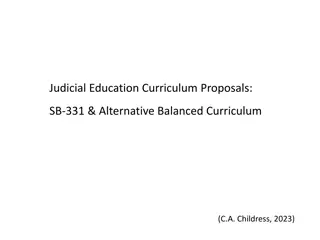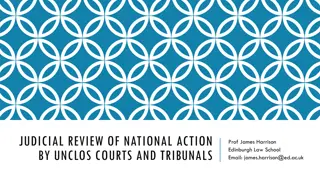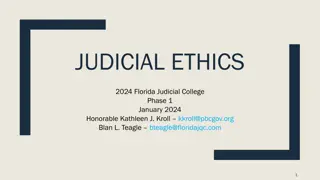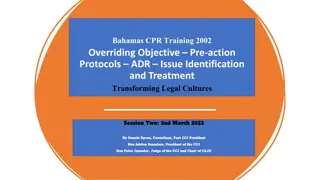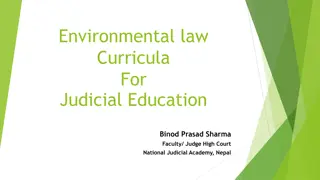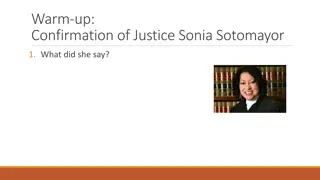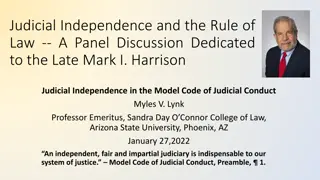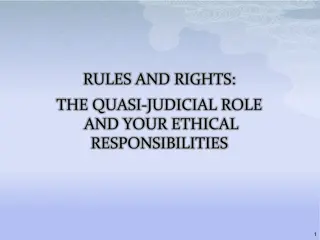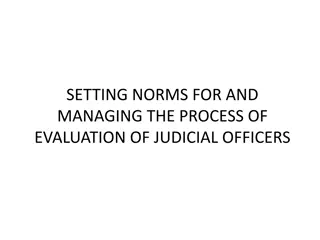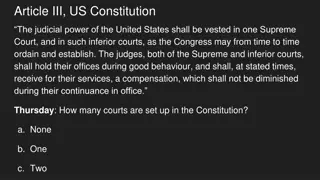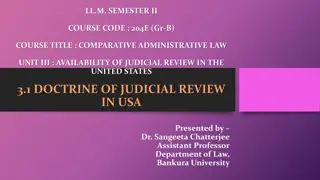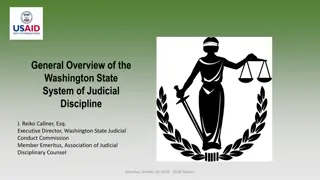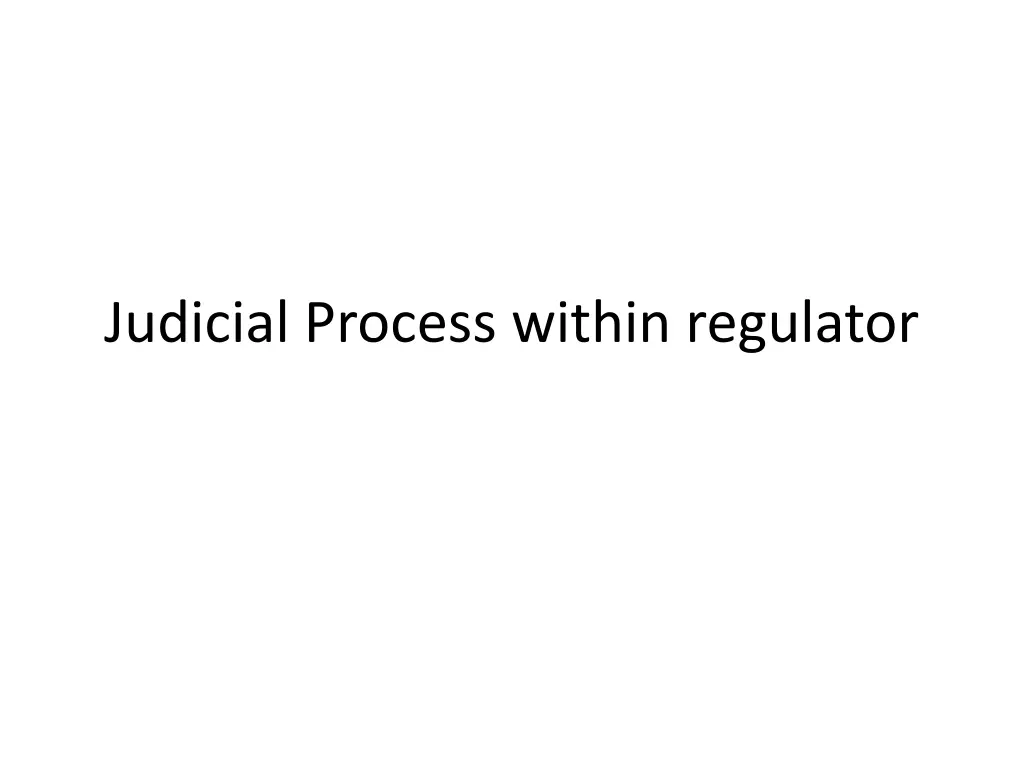
Regulatory Bodies and Judicial Process Overview
Explore the essential role of regulatory bodies in balancing stakeholder interests, preventing market failure, and promoting public interest within the commercial landscape. Understand the basic conditions, functions, and powers of regulatory bodies, alongside the distinctions between quasi-judicial authorities and traditional judicial processes. Discover the shortcomings of the judicial process in regulatory mechanisms and the challenges in resolving disputes effectively in technical subjects.
Download Presentation

Please find below an Image/Link to download the presentation.
The content on the website is provided AS IS for your information and personal use only. It may not be sold, licensed, or shared on other websites without obtaining consent from the author. If you encounter any issues during the download, it is possible that the publisher has removed the file from their server.
You are allowed to download the files provided on this website for personal or commercial use, subject to the condition that they are used lawfully. All files are the property of their respective owners.
The content on the website is provided AS IS for your information and personal use only. It may not be sold, licensed, or shared on other websites without obtaining consent from the author.
E N D
Presentation Transcript
Regulatory bodies- Genesis Commercialisation of Government functions Need for independent bodies to balance interest of various stakeholders To prevent market failure To check anti competitive practices To promote public interest To comfort Private operators Reduce transaction cost associated with Privatisation of government enterprises
Regulatory bodies-Basic conditions Created by specific legislation Independent but accountable Functions and Powers earlier enjoined on the Governments or its agencies Bring expertise in decision making Transparent and responsive process Powers of subordinate legislation
Regulatory bodies-Status Quasi Judicial authorities having status of civil court Some authorities have power to investigate and vested with penal provisions judicial bodies generally deal with bipolar centric interests which is not the case here required to balance interests of multiple groups for the overall development of the sector the procedure and processes followed are different from Judicial process
Basic features of Judicial process A passive judge rules on the basis of the record the law of evidence governs what may and may not go into the record parties adopt adversarial positions
Shortcoming of Judicial process in regulatory mechanism adversarial mode does not always lead to a complete resolution of disputes not appropriate for technical subjects that are not limited to ascertaining the facts not efficacious in influencing long-term behavioral changes among various parties Unlike the judiciary, the regulators have to work within the parameters of specified regulatory objectives, which are made clear in the legislation itself and are also bound by the stated policy of the government
Shortcoming of Judicial process in regulatory mechanism Contd.- The judicial process is largely retroactive whereas the regulatory process charged with responsibility for efficiency, growth,and sector development has to be pro-active, and, where necessary, go beyond current data to look at the future
Basic features of Regulatory bodies The conventional regulatory approach mimics judicial process to some extent, with deviation being seen primarily with regard to the evidentiary rules Alternative process seeks to get away from the adversarial model and tries to build consensus Improve the quality of information for decision-making process Recognize the multipolar nature of the disputes that come up before regulators Keep down the levels of antagonisms that lead to endless appeals.
Basic features of Regulatory bodies contd.- Quasi-Judicial Authorities Powers of Civil court to conduct enquiries Investigation powers in some cases including power to search from CrPC Principles of Natural justice Legal Precedent
Quasi judicial Authorities A quasi judicial authority is a non-judicial entity which can interpret law It is obliged to objectively determine the facts and draw objective conclusions . Right to hold hearings and conduct investigations into disputed claims Powers and procedures resembling court of law Generally limited to certain area
Powers of Civil court to conduct enquiries Discovery and Inspections Enforcing attendance of any person Production of any document Issuing commision Observing proper procedure
Search and Seizure Investigation powers including power to search and seizure Provisions of CrPC to apply in relation to search and seizures Procedural aspects
Principles of Natural justice 1. Nemo judex in causa sua a) No one should be made judge in his own case b) Rule against bias 2. Audi alteram partem a) Hear the other party b) No one should be condemned unheard c) Rule of fair hearing 3. Speaking order or reasoned decision
Speaking order An order that speaks for itself Details of the issue Ascertaining the facts of the matter Justified application of law Should stand the test of Legality Fairness Reason
Legal Precedent A Precedent is a legal casethat establishes a principle or rule. This principle is then used by the court or other judicial bodies when deciding later cases with similar issues Austin s definition is Judiciary s law Ratio Decidendi and obiter dicta
Regulatory authorities-Accountability In the earlier regime, the decisions on tariff were taken by the government or its agencies There was no provision for appeal against government s orders other tan constitutinal processes The regulatory bodies have to be accountable for their actions. There is a provision for appeal against regulatory decisions Appeals are either made in High Courts or in some cases before specialized bodies such as tribunal
Regulatory authorities-Accountability Contd- The superior courts can always intervene in regulatory decisions through their inherent power of judicial review. In addition, regulatory decisions are appealable in the High Court in most cases
Review jurisdiction The issue for discussion is what should the courts or appellate tribunals be looking for when they review or entertain appeals against regulatory decisions. whether the regulator exceeded or abused its powers; whether the regulator committed an error of law or a breach of the rules of natural justice whether a regulator reached a decision which no reasonable tribunal would have reached. Or, should they look into the merits of the case, into facts, and take decisions substituting themselves for the regulator?
Review jurisdiction Contd- In Tata Cellular vs Union of India, (1994 [6] SCC 651)the Hon ble Supreme Court reiterated these views, and laid down six principles on the basis of which administrative decisions should be reviewed. These are: the modern trend points to judicial restraint in administrative action; the court does not sit as a court of appeal but merely reviews the manner in which the decision was made; the court does not have the expertise to correct the administrative decision. If a review of the administrative decision is permitted it will be substituting its own decision, without the necessary expertise, which itself may be futile; the terms of the invitation to tender cannot be open to judicial scrutiny because the invitation to tender is in the realm of contract. Normally speaking, the decision to accept the tender or award the contract is reached by process of negotiations through several tiers. More often than not, such decisions are made qualitatively by experts; the government must have freedom of contract. In other words, a fair play in the joints is a necessary concomitant for an administra tive body functioning in an administrative sphere or quasi-administrative sphere. However, the decision must not only be tested by the application of Wednesbury principle of reasonableness (includingother facts pointed out above) but must be free from arbitrariness not affected by bias or actuated by mala fide; and quashing decisions may impose heavy burden on the administrationand lead to increased and unbudgeted expenditure.
Appellate Jurisdiction of courts As per the view taken by the courts it covers going into the facts also The two overriding considerations, namely, lack of expertise and time constraints apply equally to appeals, and present a case for restricting the courts intervention
Evaluation regulators had an opportunity to use improved processes as compared with government departments this opportunity has been utilised to a slight extent. recruitment by regulators has been from the pool of civil servants political interference on individual transactions conflicts of interest (RBI as a participants in market) separation of powers doctrine to reduce the concentration of power
Way ahead Clarity of purpose Role and composition of the board(Principal vis- -vis the management) Legislative process to be controlled by boards rather than staff Executive process should be system driven Judicial process should be separate from legislation and executive Reporting and accountability-. Regulators should be obliged to release statistical details about their functioning. The role of the department-to clarify the role of the department of government
Advertising Standards Council of India Competition Commission of India Biodiversity authority of India Press council of India Directorate General of Civil Aviation Forward Markets Commission Inland Waterways Authority of India Insurance Regulatory and Development Authority Reserve Bank of India Securities and Exchange Board of India Telecom Disputes Settlement and Appellate Tribunal Telecom Regulatory Authority of India The Food Safety and Standards Authority of India (FSSAI) Central pollution control board Financial Stability and Development Council Medical Council of India Pension fund regulatory and development authority

